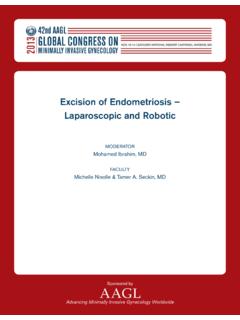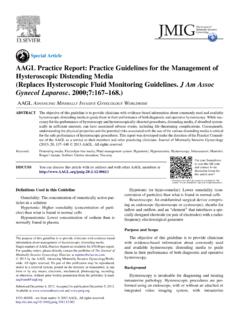Transcription of Total Laparoscopic Hysterectomy - AAGL
1 Total Laparoscopic HysterectomyHysterectomy is the second most common surgery performed in the United States. Total Laparoscopic Hysterectomy is a minimally invasive method of removing the uterus. This means that the surgeon makes only small cuts in the belly to "minimize" or lessen injury to the body. Your surgeon places a camera (laparoscope) through one small cut to see inside of your abdomen and uses little instruments through the other surgical cuts to do your surgery. The uterus then is removed through the vagina or one of the small cuts in your belly. Women who have a Laparoscopic (minimally invasive) Hysterectomy recover more quickly, have less pain, and have fewer infections than women who have one large surgical cut in the abdomen called an abdominal a Total Laparoscopic Hysterectomy , a surgeon removes your whole uterus (womb) and the opening to the uterus (cervix).
2 Sometimes other reproductive organs are removed, including the fallopian tubes (tubes sending the eggs to the uterus), or ovaries (the egg producers). Your surgeon will decide which organs may need removal depending on your age, family history, and reason for do surgeons perform this procedure?This procedure may be useful for: Heavy bleeding Fibroids(non -cancerous muscular tumors) Pre -cancer or cancer in the uterus Endometriosis or adenomyosis(when uterine tissue grows outside your uterus or within the muscular walls of the uterus) Prolapse (uterus dropping into the vagina)Benefits of the surgery: No more periods No more pap smears (for most women) No more pregnancies, so no need for birth control Improvement in pain related to periodsAlternatives to Total Laparoscopic Hysterectomy depend on the reason for having surgery, but can include: Not having any treatment Medication to manage bleeding Procedure to decrease blood supply to the uterus Surgery to remove or burn part of the uterus Removing the uterus through the vagina or through one large cut in the abdomenTop illustration.
3 A Total Hysterectomy removes the whole uterus and cervix. Bottom illustration: A cross-sectional view of a laparoscope (camera) inside the tubeTotal Laparoscopic HysterectomyWhat are the risks of this procedure?There is a small chance of having a complication or problem when you have surgery. Your risk could be higher if you have had surgery before or have othermedical conditions. Some risks of Total Laparoscopic Hysterectomy include: Bleeding during or after the surgery Infection Injury to your bladder, intestines, or other structures near your uterus Blood clots in your legs or lungs Tear in the stitches at the top of your vagina (called vaginal cuff separation) Hernia (tear or weakness in the wall of your abdomen) Need to switch to a laparotomy (surgery through one large incision)What should I expect after surgery?Everyone recovers at a different pace after surgery.
4 Many patients are able to get back to most of their usual activities by two weeks after surgery, but full recovery can take six-to-eight symptoms after Total Laparoscopic Hysterectomy include: Light vaginal bleeding Fatigue or sleepiness from anesthesia Pain or cramping in your stomach and soreness from yoursurgical cuts Shoulder pain Constipation(difficulty emptying bowels)Do not put anything in your vagina for at least six weeks (no tampons or sexual intercourse). You will no longer have periods and will not be able to become pregnant. Most women do not experience any change in sexual function after should I call my doctor?Serious problems after Total Laparoscopic Hysterectomy are uncommon, but notify your surgeon if you develop: Difficulty breathing or shortness of breath Heavy vaginal bleeding Pain not controlled by your pain medications Severe nausea and vomiting A temperature over 100 degrees Trouble urinating or having a bowel movementExamples of laparoscopichysterectomy surgical cutsDISCLAIMER: This material is for informational purposes only.
5 The information presented should not be relied on as a substitute for medical advice, independent judgment or proper assessment by a doctor, with consideration of the circumstances of each case and individual needs. The information presented here is not intended to diagnose health problems or to take the place of professional medical care. This document reflects information available at the time of its preparation. All content, including text, graphics, images and information, contained on or available through this web site is for general information purposes only. All users agree to read and abide by the AAGL s complete terms of use agreement found on its website. AAGL disclaims all liability to users of the information. 2019 AAGL. All rights reserved.












